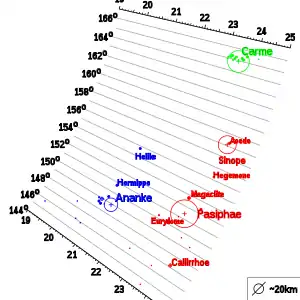Pasiphae group
The Pasiphae group is a group of retrograde irregular satellites of Jupiter that follow similar orbits to Pasiphae and are thought to have a common origin.
Their semi-major axes (distances from Jupiter) range between 22.8 and 24.1 million km (the same range as the Carme group), their inclinations between 144.5° and 158.3°, and their eccentricities between 0.25 and 0.43.

Core members of the group include (negative periods indicate retrograde orbits):[1]
| Name | Diameter (km) | Period (days) | Notes |
|---|---|---|---|
| Pasiphae | 57.8 | −722.34 | largest member and group prototype |
| Sinope | 35 | −777.29 | red colour |
| Callirrhoe | 9.6 | −722.53 | reddish colour |
| Megaclite | 5 | −717.14 | reddish colour |
| Autonoe | 4 | −711.10 | |
| Eurydome | 3 | −719.53 | |
| Sponde | 2 | −734.89 |
The International Astronomical Union (IAU) reserves names ending in -e for all retrograde moons.
Origin
The Pasiphae group is believed to have been formed when Jupiter captured an asteroid which subsequently broke up after a collision. The original asteroid was not disturbed heavily: the original body is calculated to have been 60 km in diameter, about the same size as Pasiphae; Pasiphae retains 99% of the original body's mass. However, if Sinope belongs to the group, the ratio is much smaller, 87%.[2]
Unlike the Carme and Ananke groups, the theory of a single impact origin for the Pasiphae group is not accepted by all studies. This is because the Pasiphae group, while similar in semi-major axis, is more widely dispersed in inclination.[note 1] Alternatively, Sinope might be not a part of the remnants of the same collision and captured independently instead.[4] The differences of colour between the objects (grey for Pasiphae, light red for Callirrhoe and Megaclite) also suggest that the group could have a more complex origin than a single collision.[4]


Notes
- Nesvorný 2003, concurring on the Ananke and Carme groups, lists only Megaclite for Pasiphae. However, secular resonances, known for both Pasiphae and Sinope, could shape the orbits and provide the explanation for the post-collision dispersal of the orbital elements.[3]
References
- Scott S. Sheppard, David C. Jewitt, Carolyn Porco Jupiter's outer satellites and Trojans, In: Jupiter. The planet, satellites and magnetosphere. Edited by Fran Bagenal, Timothy E. Dowling, William B. McKinnon. Cambridge planetary science, Vol. 1, Cambridge, UK: Cambridge University Press, ISBN 0-521-81808-7, 2004, p. 263 - 280 Full text(pdf). Archived 2007-06-14 at the Wayback Machine
- Sheppard, Scott S.; Jewitt, David C. (May 5, 2003). "An abundant population of small irregular satellites around Jupiter". Nature. 423 (6937): 261–263. Bibcode:2003Natur.423..261S. doi:10.1038/nature01584. PMID 12748634. S2CID 4424447. However, Nesvorny 2003, while concurring on the Ananke and Carme groups, lists only Megaclite for Pasiphae's group
- David Nesvorný, Cristian Beaugé, and Luke Dones Collisional Origin of Families of Irregular Satellites, The Astronomical Journal, 127 (2004), pp. 1768–1783 Full text.
- Grav, Tommy; Holman, Matthew J.; Gladman, Brett J.; Aksnes, Kaare Photometric survey of the irregular satellites, Icarus, 166,(2003), pp. 33-45. Preprint